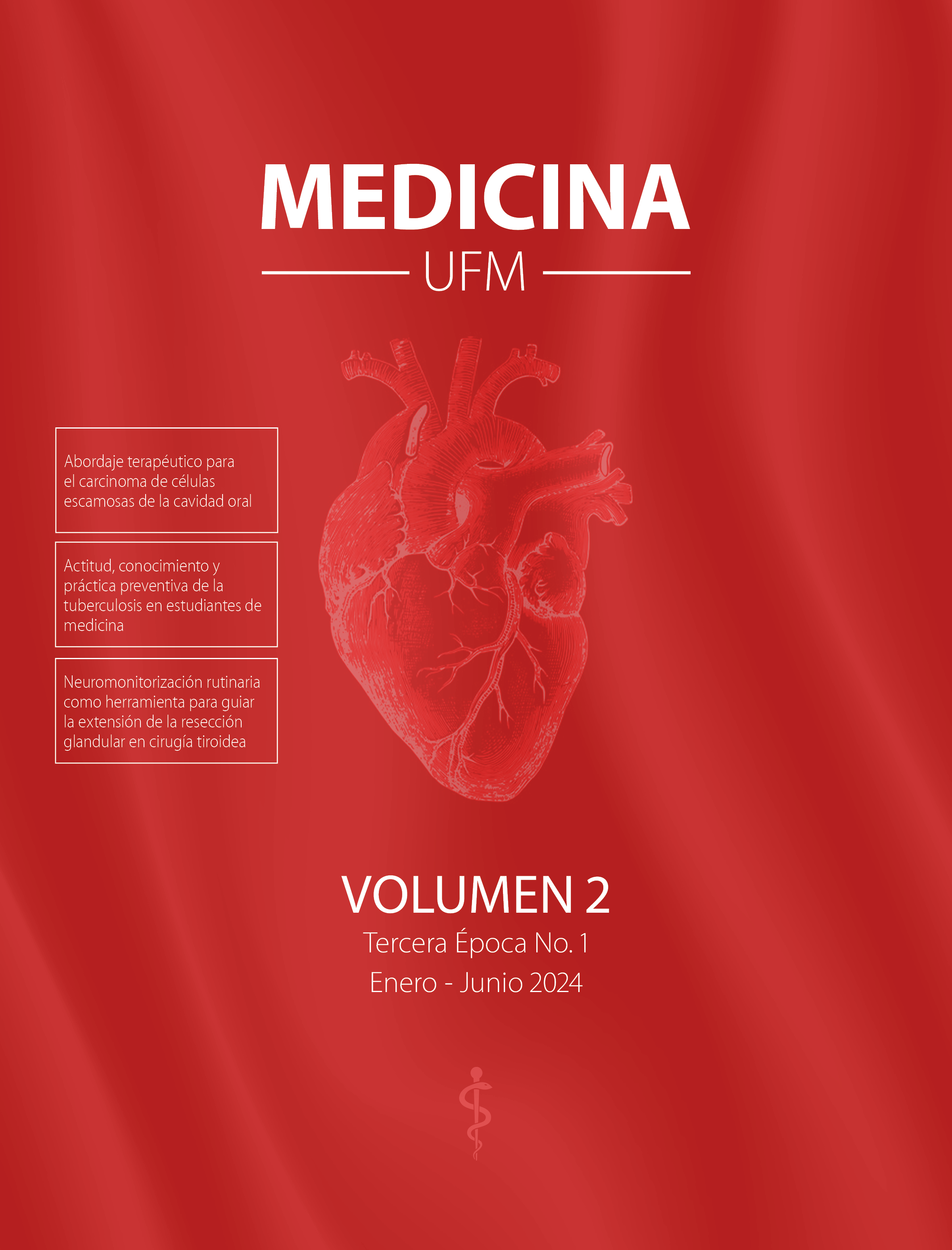Abordaje terapéutico para el carcinoma de células escamosas de la cavidad oral
DOI:
https://doi.org/10.37345/23045329.v2i1.116Palabras clave:
carcinoma de células escamosas, márgenes quirúrgicos, recurrenciaResumen
Introducción: El cáncer más común de cabeza y cuello es el cáncer de cavidad oral, conformado hasta un 90 % por carcinoma de células escamosas. Los sitios anatómicos más afectados son lengua, labios y piso de la boca. Objetivo: Determinar diferencias del abordaje terapéutico con criterios TNM octava edición AJCC vs. séptima edición para carcinoma de células escamosas de la cavidad oral en pacientes de un centro avanzado de otorrinolaringología privado. Métodos: Estudio descriptivo retrospectivo, realizado por comparación cualitativa de 40 pacientes identificados del 27/02/2009 al 18/11/2021 de un centro avanzado de otorrinolaringología. Resultados: El 70 % (28 casos) corresponden al carcinoma de células escamosas, asignados en dos grupos. Del primer grupo, el 28.57 % presentó márgenes quirúrgicos con malignidad, el 75 % recurrencia; segundo grupo, el 35.71 % presentó márgenes con malignidad, el 0 % recurrencia. El estadio I fue más frecuente con un 64.29 % y un 50 %, respectivamente. El tratamiento principal fue cirugía únicamente con un 71.43 % y un 57.14 %, respectivamente. Conclusión: Este estudio reflejó que no existe diferencia en abordaje terapéutico, aunque sí observó diferencia en edad de presentación entre ambos sexos, estadificación y recurrencia del carcinoma de células escamosas de la cavidad oral en un centro avanzado de otorrinolaringología privado.
Referencias
González, M., Riera March, A. Tongue Cancer. En: StatPearls [Internet]. Treasure Island (FL): StatPearls Publishing; 2022 January. https://www.ncbi.nlm.nih.gov/books/NBK562324/
National Cancer Institute. Tongue Cancer - Cancer Stat Facts. SEER. 2024. https://seer.cancer.gov/statfacts/html/tongue.html
American Cancer Society. Cancer staging. Diagnosing and staging cancer. Has cancer spread. Cancer prognosis. 2018, February, (Last revised) https://www.cancer.org/cancer/diagnosis-staging/staging.html
Kato, M.G., Baek, C.H. Update on oral and oropharyngeal cancer staging - International perspectives. World J Otorhinolaryngology Head Neck Surg. 2020, Mar. 6; 6(1): 66-75. DOI: https://doi.org/10.1016/j.wjorl.2019.06.001 DOI: https://doi.org/10.1016/j.wjorl.2019.06.001
Mannelli, G., Arcuri, F. Classification of tongue cancer resection and treatment algorithm. J Surg Oncol. 2018, April; 117(5): 1092-1099. DOI: https://doi.org/10.1002/jso.24991 DOI: https://doi.org/10.1002/jso.24991
Piazza, C., Bresciani, L., Giannini, L. Depth of invasion for prognostic stratification in oral cavity cancer: do we need further validation? Ann Transl Med. 2019, Jul; 7(Suppl 3): S84. DOI: http://dx.doi.org/10.21037/atm.2019.04.19 DOI: https://doi.org/10.21037/atm.2019.04.19
Kirtane, K., & Rodríguez, C.P. Postoperative Combined Modality Treatment in High Risk Resected Locally Advanced Squamous Cell Carcinomas of the Head and Neck (HNSCC). Frontiers in Oncology. 2018, Dec.; vol. 8. https://doi.org/10.3389/fonc.2018.00588 DOI: https://doi.org/10.3389/fonc.2018.00588
Hinni, M. L., Ferlito, A. Brandwein-Gensler, M.S., Takes, R.P., Silver, C.E., Westra, W.H., et al. Surgical margins in head and neck cancer: A contemporary review. Head & Neck, 2013, Sept.; 35(9): 1362–1370. DOI: https://doi.org/10.1002/hed.23110 DOI: https://doi.org/10.1002/hed.23110
Hermanek, P., & Wittekind, C. The Pathologist and the Residual Tumor (R) Classification. Pathology Research and Practice. 1994, Feb.; 190(2): 115–123. DOI: https://doi.org/10.1016/S0344-0338(11)80700-4 DOI: https://doi.org/10.1016/S0344-0338(11)80700-4
Rivera, C. Essentials of oral cancer. Int. J. Clin Exp Pathol. 2015, Sept.; 8(9): 11884-11894. https://www.ncbi.nlm.nih.gov/pmc/articles/PMC4637760/
Ettinger, K.S., Ganry, L., & Fernandes, R.P. Oral cavity cancer. Oral and Maxillofacial Surgery Clinics of North America, 2019. Feb.; 31(1), 13–29. https://doi.org/10.1016/j.coms.2018.08.002 DOI: https://doi.org/10.1016/j.coms.2018.08.002
McCullough, M.J., Prasad, G., & Farah, C.S. Oral mucosal malignancy and potentially malignant lesions: an update on the epidemiology, risk factors, diagnosis, and management. Australian Dental Journal, 2010, May; 55(s1): 61–65. https://doi.org/10.1111/j.1834-7819.2010.01200.x DOI: https://doi.org/10.1111/j.1834-7819.2010.01200.x
Amezaga-Fernández, I., Aguirre-Urizar, J.M., Suárez-Peñaranda, J.M., Chamorro-Petronacci, C., Lafuente-Ibáñez de Mendoza, I., Marichalar-Mendía, X., et al. Epidemiological, clinical, and prognostic analysis of oral squamous cell carcinoma diagnosed and treated in a single hospital in Galicia (Spain): a retrospective study with 5-year follow-up. Medicina oral patología oral y cirugía bucal. 2024, Jan., 29(1): e36-43. https://doi.org/10.4317/medoral.26047 DOI: https://doi.org/10.4317/medoral.26047
Zanoni, D.K., Montero, P.H., Migliacci, J.C., Shah, J.P., Wong, R.J., Ganly, I., et al. Survival outcomes after treatment of cancer of the oral cavity (1985–2015). Oral Oncology. 2019, March; 90: 115–121. doi: https://doi.org/10.1016/j.oraloncology.2019.02.001 DOI: https://doi.org/10.1016/j.oraloncology.2019.02.001
Loree, T.R., & Strong, E.W. Significance of positive margins in oral cavity squamous carcinoma. The American Journal of Surgery. 2019, Oct.; 160(4), 410–414. https://doi.org/10.1016/s0002-9610(05)80555-0 DOI: https://doi.org/10.1016/S0002-9610(05)80555-0
Descargas
Publicado
Número
Sección
Licencia
Derechos de autor 2024 José Javier Quevedo Fernández y Juan Pablo Díaz Molina

Esta obra está bajo una licencia internacional Creative Commons Atribución-NoComercial-CompartirIgual 4.0.
Aquellos autores/as que tengan publicaciones con esta revista, aceptan los términos siguientes:
- Los autores/as conservarán sus derechos de autor y garantizarán a la revista el derecho de primera publicación de su obra, el cuál estará simultáneamente sujeto a la Licencia de Reconocimiento-No Comercial-CompartirIgual 4.0 Internacional de Creative Commons que indica: a) Está permitido que terceros compartan la obra siempre que se le crédito a su autor y se indique su primera publicación en esta revista, b) La obra no puede ser usada con fines comerciales, c) Si se remezcla, transforma o crea a partir de la obra, se debe distribuir su contribución bajo la la misma licencia de la obra original.
- Los autores/as podrán adoptar otros acuerdos de licencia no exclusiva de distribución de la versión de la obra publicada (p. ej.: depositarla en un archivo telemático institucional o publicarla en un volumen monográfico) siempre que se indique la publicación inicial en esta revista.
- Se permite y recomienda a los autores/as difundir su obra a través de Internet (p. ej.: en archivos telemáticos institucionales o en su página web) antes y durante el proceso de envío, lo cual puede producir intercambios interesantes y aumentar las citas de la obra publicada. (Véase El efecto del acceso abierto).






